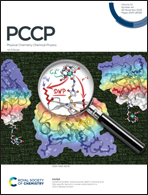Unimolecular photolysis mechanisms of formamide: the effect of thermal energy†
Abstract
The photochemistry of molecules with peptide bonds is of both theoretical and experimental interest. Among these molecules, formamide (HCONH2) has been frequently selected as a representative in the study of proteins. Because several fundamental questions remained unanswered, particularly the role of thermal energy, the unimolecular photodissociations of HCONH2 were studied using the CASPT2(6,9)/aug-cc-pVDZ method and transition state theory (TST). The theoretical results verify that C–N dissociation is both kinetically and thermodynamically favorable in the S1 state. In addition, the dissociated radical products (HCO and NH2) could be precursors in the other dissociation channels owing to their high reactivities. The NH3–CO and NH3–OC H-bond complexes were reportedly observed to display the highest quantum yield in a UV experiment because the processes for determining the rates of isomerization dissociations of HCO and NH2 (which involve formyl hydrogen transfer) are spontaneous and kinetically favorable. Similarly, the van der Waals complex between HNCO and H2 represents the common end product with HCO and NH2 as the precursors. This is because the S1 and T1 relax-scan potential energy curves for the dehydrogenation straightforwardly intersect the S0 state with approximately similar structures at the intersection points. Therefore, the promotion of the intersystem crossing by a noble-gas cryogenic matrix appears inessential as previously reported. In contrast, we conjectured that the xenon matrix used in the UV experiment helps promote the van der Waals complex by reducing the energy barriers for dehydrogenation rather than by enhancing the rate of intersystem crossing from the singlet to triplet state. It was concluded that HCN, HNC, and H2O (dehydration) were formed via a two-step process, wherein, the cleavage of the C–O bond in formamidic acid first occurs in the S1 state. This is followed by the hydrogen/proton transfer from HCNH to OH on barrierless potentials. Overall, the mechanisms proposed in this work reveal the role of thermal energy and effects of variations in the multiconfigurational characteristics along the potential energy curves in detail. The available information on these aspects is limited, and the present results could provide insights into unimolecular photodissociations; these could be beneficial in future theoretical and experimental studies on this and other similar systems.



 Please wait while we load your content...
Please wait while we load your content...